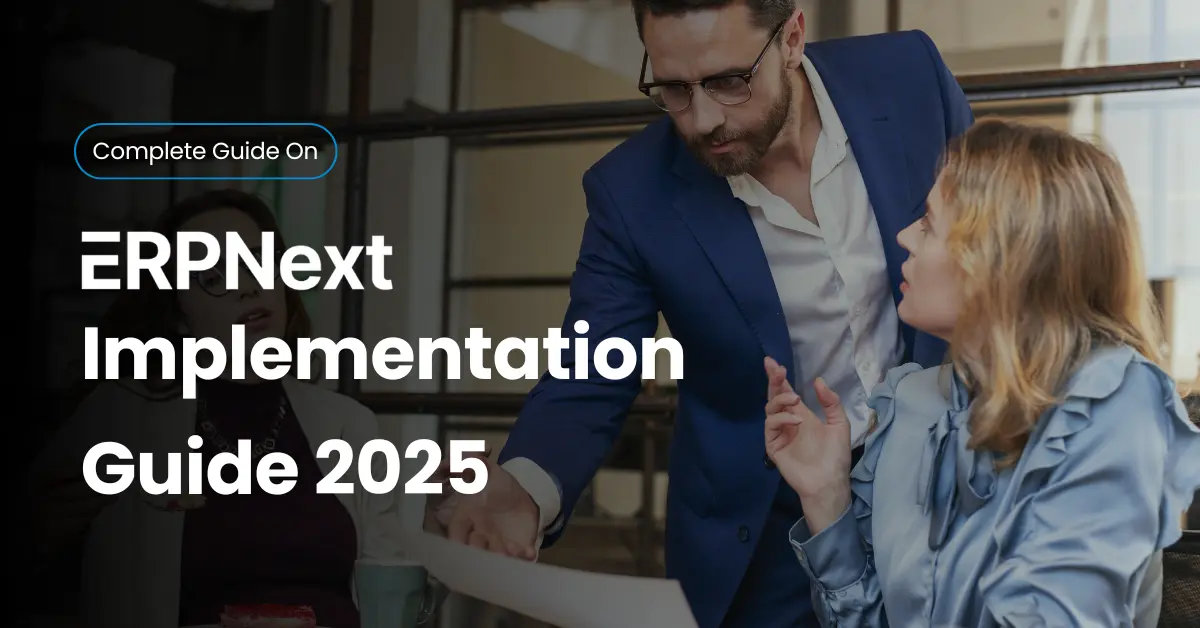Digital transformation in 2025 is not optional — it’s necessary for upgradation. Every business across manufacturing, trading, and services is adopting automation to cut inefficiencies and boost productivity. One name leading this revolution is ERPNext, an open-source ERP platform designed for flexibility and scalability.
In this guide, we’ll walk you through every stage of ERPNext implementation — from planning and setup to go-live and beyond. Whether you’re a small manufacturer or an operations manager aiming to modernize your systems, this is your roadmap to success.
Infintrix Technologies, a certified ERPNext implementation partner, helps businesses streamline operations with proven ERP strategies and expert support.
Why ERPNext Leads the Future of ERP Systems in 2025
When you think of modern ERP software, ERPNext stands out for one simple reason — it gives businesses complete control without the hefty license fees of traditional ERPs. Built on the Frappe Framework, it’s powerful, flexible, and fully open source.
With its modular design, ERPNext supports key business functions like CRM, HR, Accounting, Project Management, and Supply Chain Management (SCM). Whether you’re hosting on-premise or using Frappe Cloud, ERPNext adapts easily to your operational needs.
Quick Highlights:
- 100% open-source and customizable ERP system
- Scalable architecture powered by the Frappe Framework
- Cloud-ready with deployment options via AWS or Frappe Cloud
- Integrates seamlessly with Google Workspace, Shopify, and WooCommerce
- Ideal for SMEs, manufacturers, and growing businesses
Here’s the key takeaway: ERPNext isn’t just a tool — it’s a digital backbone that unifies your processes under one intelligent system.
ERPNext vs Other ERP Solutions — Smart Comparison for Decision-Makers
Choosing an ERP solution can feel overwhelming — every vendor claims to be the best. But when you compare ERPNext with alternatives like Odoo, SAP Business One, and NetSuite, its value becomes clear. ERPNext combines affordability, flexibility, and total ownership — no hidden costs or vendor lock-ins.
Here’s a simple comparison to help you evaluate the right ERP for your business:
| Feature / Factor | ERPNext | Odoo | SAP Business One | NetSuite |
| Licensing | Free & Open Source | Freemium | Proprietary | Proprietary |
| Customization | Extensive (via Frappe Framework) | Moderate | Limited | Limited |
| Hosting Options | Cloud / On-premise | Both | Cloud | Cloud |
| Integrations | Shopify, Tally, Google Workspace | Odoo Apps | Add-ons | Add-ons |
| Ideal For | SMEs, Manufacturers | SMEs | Enterprises | Large Organizations |
| Cost Efficiency | ★★★★★ | ★★★★☆ | ★★☆☆☆ | ★★☆☆☆ |
Pro tip: If you value freedom, customization, and transparency, ERPNext easily outperforms traditional ERPs that charge high licensing fees for the same functionality.
Key ERPNext Features That Drive Business Success
The strength of ERPNext lies in its modular, all-in-one design. Instead of juggling multiple tools, businesses can run everything — from accounting to production — within a single system.
Let’s explore what makes ERPNext a complete business management solution:
- Accounting & Finance: Automate ledgers, track transactions, and maintain a structured Chart of Accounts (COA) for accurate reporting.
- CRM: Manage leads, automate follow-ups, and boost conversion rates with built-in Customer Relationship Management tools.
- HR & Payroll: Streamline hiring, attendance, and payroll cycles for improved workforce management.
- Inventory & SCM: Real-time warehouse tracking and efficient Supply Chain Management ensure zero stockouts.
- Manufacturing: Manage Bill of Materials (BOM), production scheduling, and work orders effortlessly.
- Projects & Tasks: Improve team coordination with integrated Project Management features.
- Integrations: Connect with REST APIs for Shopify, Tally, and WhatsApp integrations.
For example, A mid-sized manufacturing firm using ERPNext for production and inventory reported 40% faster turnaround on purchase orders — all thanks to automation across departments.
That said, the real power of ERPNext lies in its flexibility. Whether you’re a startup or a multi-branch manufacturer, the platform grows with you.
How to Plan a Successful ERPNext Implementation in 2025
A smooth ERPNext implementation starts with a solid plan. Before jumping into setup or customization, it’s crucial to define your business goals, assess readiness, and align stakeholders. Think of this stage as laying the foundation for your ERP journey.
Partnering with an experienced team like Infintrix Technologies ensures your implementation is strategic, efficient, and aligned with business objectives — from initial discovery workshops to roadmap creation.
Step 1 — Define Business Goals and KPIs
Before touching any settings, clarify why you’re implementing ERPNext. Identify measurable Key Performance Indicators (KPIs) such as reduced process time, increased reporting accuracy, or faster order fulfillment.
By linking every ERPNext module to a specific goal, you’ll track ROI effectively post-go-live.
Step 2 — Conduct Business Process and Gap Analysis
Map your current workflows — from purchasing to payroll — and compare them with ERPNext’s capabilities. This gap analysis helps identify inefficiencies and areas for automation.
Quick tips:
- Prioritize high-impact areas like inventory and accounting first.
- Avoid overcomplicating initial setups; start with core modules and expand later.
Step 3 — Prepare a Practical Implementation Timeline
Every ERPNext project plan varies depending on company size, complexity, and customization needs. Here’s a simplified breakdown to guide your expectations:
| Project Type | Typical Duration | Activities |
| Small Business | 3–5 months | Module setup, basic customization, data migration |
| Medium Business | 6–8 months | Multi-department rollout, integrations, training |
| Enterprise | 9–12 months | Complex workflows, custom APIs, full-scale deployment |
Pro tip: Stick to realistic milestones and allocate dedicated internal champions to ensure accountability.
ERPNext Implementation Framework — 8 Phases to Success
Successful ERPNext implementation isn’t about speed — it’s about structure. Below is a clear, eight-phase framework designed to take your business from discovery to continuous improvement.
Phase 1 – Discovery & Blueprint
Start by understanding your unique requirements. Define workflows, data points, and essential modules. This blueprint acts as your ERPNext implementation map and ensures everyone’s aligned before setup begins.
Phase 2 – System & Module Configuration
Use ERPNext’s Frappe Framework to configure key modules like Accounting, HR, and CRM. Set up permissions, create your Chart of Accounts (COA), and design user roles to match your hierarchy.
Phase 3 – Data Migration
Clean, consistent data is the backbone of a successful ERP setup. Prepare your master data (customers, items, suppliers) and validate it before import. ERPNext’s Data Import Tool and APIs make this process smooth and auditable.
Phase 4 – Customization & Integrations
Adapt ERPNext to fit your workflows — not the other way around. Add custom fields, create print formats, and integrate systems like Shopify, WooCommerce, or AWS for seamless synchronization.
Phase 5 – Testing & User Acceptance Testing (UAT)
Conduct end-to-end testing with your project team. During UAT, ensure that real users validate every module, workflow, and report before final rollout. Document all issues and address them promptly.
Phase 6 – User Training & Change Management
ERP success depends on people, not just software. Train teams using live demos, sandbox access, and role-based sessions. Incorporate change management strategies to ease resistance and build confidence.
Phase 7 – Go-Live Execution
This is the big day. Migrate final data, switch to live operations, and monitor every transaction. Keep your support team ready to resolve any early-stage hiccups quickly.
Phase 8 – Post-Go-Live Optimization
Once ERPNext is live, your work isn’t over. Use KPIs to measure performance, implement feedback, and gradually add more modules. Continuous improvement ensures your ERP stays efficient and future-ready.
Real-World ERPNext Success Story — From Complexity to Clarity
Every business transformation starts with a challenge. Here’s an example of how ERPNext can make a measurable difference.
Client Overview: A mid-sized manufacturing company, Pak Tools struggling with manual accounting and fragmented inventory systems.
Challenge: Data management, poor visibility, and delayed financial reports.
Solution: ERPNext implemented by Infintrix Technologies, integrating Accounting, CRM, and Inventory modules.
Results:
- 40% faster order processing
- 30% improvement in stock accuracy
- Real-time financial dashboards are accessible company-wide
Key takeaway: With the right partner, ERPNext implementation delivers measurable ROI — not just automation.
ERPNext Implementation Challenges (and How to Overcome Them)
Even the best ERP projects face hurdles. Awareness is the first step to avoiding them.
Common Challenges & Fixes:
- Data Migration Errors: Validate and test small data sets before full migration.
- User Resistance: Communicate early and emphasize benefits through interactive training.
- Customization Overload: Focus on essential modules during phase one.
- Lack of Post-Go-Live Support: Partner with experienced firms offering continuous support and optimization.
Pro tip: Regular reviews after go-live help catch and resolve issues before they impact operations.
Cost, Timeline, and ROI of ERPNext Implementation
Understanding the cost and value of ERPNext implementation helps you budget wisely and set realistic ROI expectations.
Key Factors Influencing Cost
- Number of modules deployed
- Data complexity and migration volume
- Hosting (on-premise vs. cloud)
- Training and support requirements
ROI Calculation Example
| Metric | Before ERPNext | After ERPNext | ROI Improvement |
| Order Processing Time | 4 days | 1 day | +75% Efficiency |
| Reporting Accuracy | 60% | 95% | +35% Accuracy |
| Operating Cost | 100% | 80% | -20% Cost Reduction |
When implemented strategically, ERPNext typically yields full ROI within 12–18 months.
Best Practices for Long-Term ERPNext Success
Maintaining ERP performance over time requires discipline and planning.
Quick Checklist:
- Start with essential modules before expanding.
- Keep your master data clean.
- Track KPIs monthly for visibility.
- Stay updated with Frappe releases.
- Engage with the ERPNext community for support and innovation.
Tip: Regular optimization cycles ensure ERPNext scales effortlessly with your business growth.
FAQs About ERPNext Implementation
1. How much does ERPNext implementation cost in 2025?
Costs vary depending on project size and complexity, but are generally lower than proprietary ERPs thanks to ERPNext’s open-source model.
2. How long does an ERPNext implementation take?
Typically, 3–5 months for small businesses and 6–12 months for larger deployments.
3. Can ERPNext integrate with Shopify or Tally?
Yes. ERPNext supports REST API and ready integrations for Shopify, Tally, and other third-party tools.
4. Is ERPNext suitable for manufacturing and retail?
Absolutely. With built-in BOM, production planning, and SCM tools, it’s ideal for manufacturers and traders.
5. Do I need an IT team to manage ERPNext?
Not necessarily. With partners like Infintrix Technologies and hosting options like Frappe Cloud, maintenance is simplified.
Conclusion — Transform Your Business with ERPNext in 2025
Implementing ERPNext isn’t just a tech upgrade — it’s a strategic business move. With its open-source flexibility, robust features, and strong community, ERPNext empowers businesses to automate, analyze, and scale efficiently.
At Infintrix Technologies, we’ve helped manufacturers, service firms, and distributors achieve measurable growth through seamless ERPNext implementations. Whether you’re starting your first ERP project or optimizing an existing system, our experts ensure a smooth, tailored, and ROI-driven journey.
Ready to streamline your operations?
Let ERPNext — powered by Infintrix Technologies — be the foundation of your next phase of digital transformation.

